Of Old Radios And Related Items--Published Monthly
A Commemoration of the First Wireless
Transmission on the West Coastby Paul Joseph Bourbon
WEB EDITION
This is the second of two articles by Paul Bourbin that were mistakenly put on hold in our filing system some time ago. However, a historic radio event is always worth recording, no matter how many years after the fact. (Editor)
On Saturday morning, August 28, 1999, a group of about fifty radio historians, supported by the United States Coast Guard, a historian and a naturalist from the National Park Service, the press and a few bemused tourists, commemorated the 100th anniversary of the first working wireless signals in America. The California Historical Radio Society, the Perham Foundation, the San Francisco Amateur Radio Club, the Golden Gate National Recreation Area (GGNRA), owners of the Cliff House, and the United States Coast Guard sponsored the ceremony.
The first wireless message hit the ether on August 23, 1899. Within the United States, three separate wireless transmission events occurred about the same time in 1899. The evidence suggests that the transmission of August 23, 1899, was, indeed, the first wireless transmission in the United States, or, perhaps, even the Western Hemisphere.
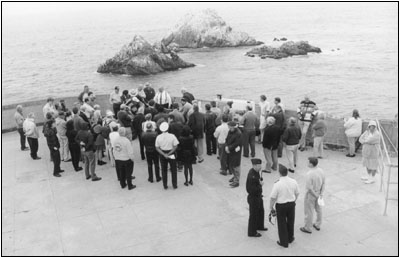
An overview of the event taken from the Cliff House. Note the Seal Rocks in the background.
In August 1899, it was known that the troopship Sherman was returning to San Francisco from the Philippine Islands with California's regiment of soldiers who fought in the Spanish American War. The city had planned a big celebration for the soldiers upon their return. Therein lay the rub. No one could be exactly sure when the troopship would arrive.
It was known that, before reaching San Francisco, the Sherman would have to pass by the lightship San Francisco, located nine miles outside the Golden Gate. This would give ample time to inform San Franciscans of the arrival of the troopship, but how could the message be sent to the city? More often than not, in August, the area around the Golden Gate is enshrouded in fog, so traditional methods would not work.
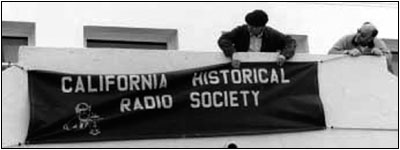
CHRS President, Steve Kushman, and CHRS member Paul Bourbin putting up the Society's banner prior to the event.
George Mitchell's Idea
George Otis Mitchell, a physics teacher at Girl's High School, had experimented with wireless telegraphy. He had the idea that if a wireless transmitter were put onboard the San Francisco, a lookout could report sighting of the Sherman. A receiver located in the city would then pick up the message and relay it via telephone lines. A group of men got together to accomplish this task. The newspaper San Francisco Call, seeking a scoop, sponsored the venture.
At first, tests of the apparatus, initially a Tesla Coil, were made from the Spreckles Building, in downtown San Francisco to Telegraph Hill, with mixed results due to interference from trolley cars. Later, the receiver was moved to the Cliff House overlooking the Pacific Ocean. This location was away from trolley cars and closer to the lightship. It also had a telephone connection.
A Ruhmkorff coil spark transmitter was installed on the San Francisco, and the wait began. About 5:00 p.m., the Sherman was sighted through the fog, and Charles Fisher tapped out, "Sherman is sighted." He had only the spark transmitter and no way of knowing if the message had been received. Fortunately, it was.
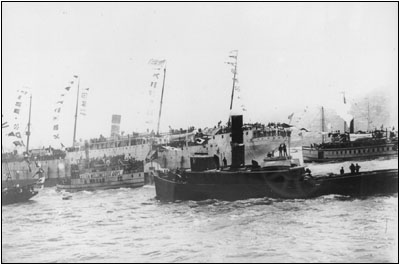
An 1899 photograph of the troopship USAT Sherman (background), and other vessels, which was part of the Cliff House exhibit.
The coherer, connected to a 75-foot vertical wire with a "capacity hat," detected the signals, and the Morse inker noted them. A telephone call was made from the Cliff House to the San Francisco Call with the happy news. A cannon was fired from atop the Spreckles Building, followed by other signals. The city welcomed the Sherman and her heroes and celebrated for three days -- they really knew how to throw a party!
100 Years Later
The commemoration on August 28, 1999, was not quite as spectacular, but the magic was still there. While the commemoration did not start until 10:00 a.m., members of the various groups were busy setting up all the myriad things necessary for the event. Among them were the exhibits of early equipment, a VCR and TV to play the commemorative documentary produced by CHRS President Steve Kushman and aired on KGO-TV, the modern radio transmitter and receiver to be used for the reenactment, public address equipment, etc.
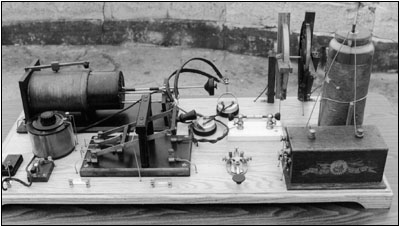
This fully-operational 15-watt spark transmitter and receiver was assembled using vintage parts by Paul Bourbin.
At the appointed hour, CHRS President Steve Kushman welcomed one and all and outlined the significance of the day and the events to occur. Don Koijane, President of the Perham Foundation, explained the need for historical preservation and the Foundation's plans for an electronics museum. Richard Everett, Curator of the San Francisco National Maritime Museum, spoke about its new radio wing.
Other speakers included Steve Haller of the GGNRA who gave a talk about the Presidio and its wars. Bob Holloway, also of the GGNRA, talked about the Cliff House site, its fog and environs. Col. Earnest James gave listeners background information about the First California Volunteers Regiment's involvement in the Spanish American War. Historian Bart Lee, also impresario of the event, told listeners about the technology of the day and the event that occurred on that day 100 years ago.
Captain Charles Williams spoke on behalf of the Coast Guard whose predecessors operated the lightship. Paul Bourbin explained how spark transmitters work while the President of the San Francisco Amateur Radio Club, Alan Schuman demonstrated Paul's transmitter. Spark signals were received on at least one portable transistor radio. Then it was time for the reenactment.
The Reenactment
From a Coast Guard cutter located just beyond Seal Rocks, under the command of Lt. Mike Fazio, came the Morse Code transmission, "Sherman is sighted", which was relayed through the P.A. system via a Coast Guard receiving station set up by Chief Warrant Officer John Kedge for the purpose. People were then invited to watch the documentary video and ask questions. Upon conclusion of the event, those who participated retired to a fine repast in the elegant dining room of the Cliff House.
On exhibit for the event was a coherer supplied by Will Jensby, an officer of the Perham Foundation and of CHRS, a Morse inker supplied by Curator Ed Gable of the Antique Wireless Association, and the commemorative illustration, drawn by CHRS member Kent Leech. Also, there was an operating, reconstructed 15-watt spark transmitting and receiving station made of vintage parts, owned by Paul Bourbin.
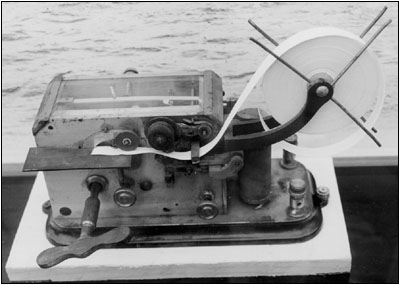
This vintage Morse telegraph inker-printer was one of the early equipment seen in the Cliff House.
The San Francisco Maritime Museum amateur radio station, K6KPH, manned by Tom Horsfall and Dick Dillman, copied the commemorative message and responded with a QST QSL message on the 80-meter Ham band. The AWA station in upstate New York also copied the message transmitted by the Coast Guard cutter and responded. The event was reported on several news programs, including San Francisco TV station KRON, and in the newspaper, San Francisco Examiner.
It was a very pleasant event. Everyone looks forward to commemorating the early modulated-spark, voice transmissions, the first Radio-Telephone, made by the McCarty brothers in 1902 from the same location.
© October 1999, Paul Joseph Bourbin. All rights reserved.
(Paul J. Bourbin, 25 Greenview Ct., San Francisco, CA 94131)
Paul Bourbin's fascination with radio goes back to his teenage years. His collection spans the time from wireless to the transistor radio and consists largely of sets he has brought back to life from the junk heap. A past chairman and president of the Board of the California Historical Radio Society, he has written for various old radio publications.
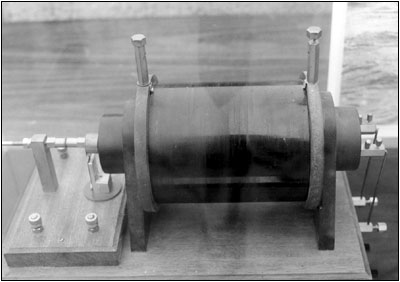
This early spark coil was displayed in a glass case as part of the Cliff House exhibit.
| [Free Sample] [Books, etc., For Sale] [Subscribe to A.R.C./Renew] [Classified Ads] [Auction Prices] [Event Calendar] [Links] [Home] [Issue Archives] [Book Reviews] [Subscription Information] [A.R.C. FAQ] URL = http://www.antiqueradio.com/Dec03_Bourbin_FirstWireless.html Copyright © 1996-2003 by John V. Terrey - For personal use only. Last revised: November 28, 2003. For Customer Assistance please contact ARC@antiqueradio.com or call (866) 371-0512 Pages designed/maintained by Wayward Fluffy Publications
Antique Radio Classified |